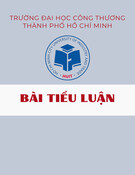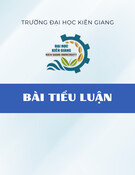
MINISTRY OF EDUCATION AND TRAINING MINISTRY OF FINANCE
ACADEMY OF FINANCE
PHAM MINH VIET
MANAGEMENT OF SOCIAL INSURANCE
COLLECTION IN VIETNAM
MAJOR: FINANCE – BANKING
ID: 9.34.02.01
SUMMARY OF DOCTORAL THESIS
HA NOI - 2019

THE THESIS WAS COMPLETED AT
ACADEMY OF FINANCE
Supervisor: Associate Professor, Doctor Hoang Manh Cu
Reviewer 1:
Reviewer 2:
Reviewer 3:
The thesis was defended before Academy of Finance
Thesis Committee
At: 2019
Find more about the thesis from:
- National library
- Academy of Finance library

LIST OF THE AUTHOR’S WORKS RELATED TO THE
THESIS
1. Pham Minh Viet (2018), “Experience from a number of countries on
management of social insurance collection and lessons for Vietnam”,
Journal of Fiance - Accounting Studies, issue 01, pg.53-56.
2. Pham Minh Viet (2018), “Enhancing the revenue for social insurance
in the context of Industrial Revolution 4.0”, Journal of Commerce,
issue14, pg.376-381.
3. Pham Minh Viet (2019), “Current situation on compulsory social
insurance collection and a number of solutions” Journal of Fiance -
Accounting Studies, issue 01, pg.66-69.

1
INTRODUCTION
1. Rationale
Social insurance is the single most important social policy in each
country's social security system. Social insurance contributes to social
security, ensures citizens’ comfortable lives, as well as promotes social
justice and economic growth. This is one of the most important items in
the social policy agenda that our Party and State have paid special
attention to in recent years.
The social insurance policy in our country had an early history,
originating from the Government’s issuance of Decree No. 12 / CP on
January 26, 1995 on the promulgation of social insurance regulations
and Decree No. 19 / CP on February 16, 1995 on the establishment of
Vietnam Social Security which marks a reform of the social insurance
system. The social insurance fund is now independent of the State
budget, operating under the contribution- benefit sharing principle, i.e.
more contribution from participants means a larger fund. This is a
prerequisite to ensure legal rights and benefits for employees. Over the
past years, the social insurance collection policy has been supplemented
and amended on various aspects including participants, methods and
processes of social insurance collection, especially after Social
Insurance Law came into effect on January 1, 2007.
The Party and the State showed even greater interest in the social
insurance policy at the 7th Convention, wherein the 12th Central
Executive Committee of the Communist Party of Vietnam discussed and
made various adjustments to the Bill of social insurance policy reform
and agreed unanimously on the issuance of Resolution No. 28-NQ / TW
on May 23, 2018 on reforming social insurance policies.
There is growing practical evidence in recent years that show
remarkable achievements have been accomplished in social insurance
policies as well as the management and implementation of these
policies, synonymous with the development of the national social
security system in general and the social insurance system in particular.
With the leading role of the State, the participation of employees and
employers, the Social Insurance Fund has become the largest welfare

2
fund, operating on the principle of contribution - benefit sharing.
Revenue source for social insurance fund is growing exponentially while
social insurance coverage in accordance with the law and the number of
participants are both increasingly expanded. According to Vietnam
Social Insurance, as of 2017, the total number of people participating in
social insurance is about 13.9 million (of which: 13.6 million are
compulsory social insurance participants and 0.3 million are voluntary
social insurance participants), an increase of more than 2 , 3 times over
the period from the effective date of Social Insurance Law No. 71/2006 /
QH11.
Social insurance collection management is one of the most
important and difficult tasks of the social insurance industry. The overall
coverage is still limited compared to other countries in the region; the
risk of budget imbalance attached to the Social insurance fund is still
inherent in the medium and long term; social insurance schemes lack
diversity and flexibility which make them less attractive to potential
participants; paperwork and procedures are yet to be streamlined to
accommodate businesses and employees. There are widespread reports
of employees taking advantage of social insurance loopholes to seek
undue insurance benefits, causing loss to the social insurance fund while
a high number of businesses are behind on social insurance premium
payment or attempt to evade payment. In addition, the current low
growth rate of social insurance revenue is incommensurate with the
potential. According to 2017’s statistics, social insurance coverage
accounted for just nearly 29% of the workforce in the age group eligible
for social insurance while over 70% are not covered. Currently more
than 300,000 businesses are operating without offering social insurance
to employees.
With a view to overcoming the aforementioned limitations, and in
order to expand and diversify the social insurance revenue sources,
sustainably develop the social insurance fund, it is of paramount
importance to have pragmatic and effective measures in the coming
period.
Keeping those issues in mind, the author’s research topic
"Management of social insurance collection in Vietnam" is highly
relevant and necessary in today’s context.

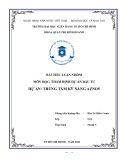


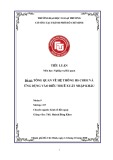
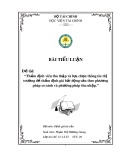
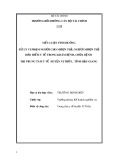
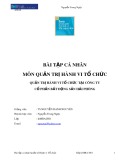
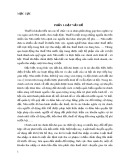

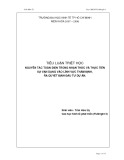

![Thẩm định dự án đầu tư Ngân hàng BIDV: Bài tiểu luận [chuẩn nhất]](https://cdn.tailieu.vn/images/document/thumbnail/2025/20251018/kimphuong1001/135x160/7231760775689.jpg)





